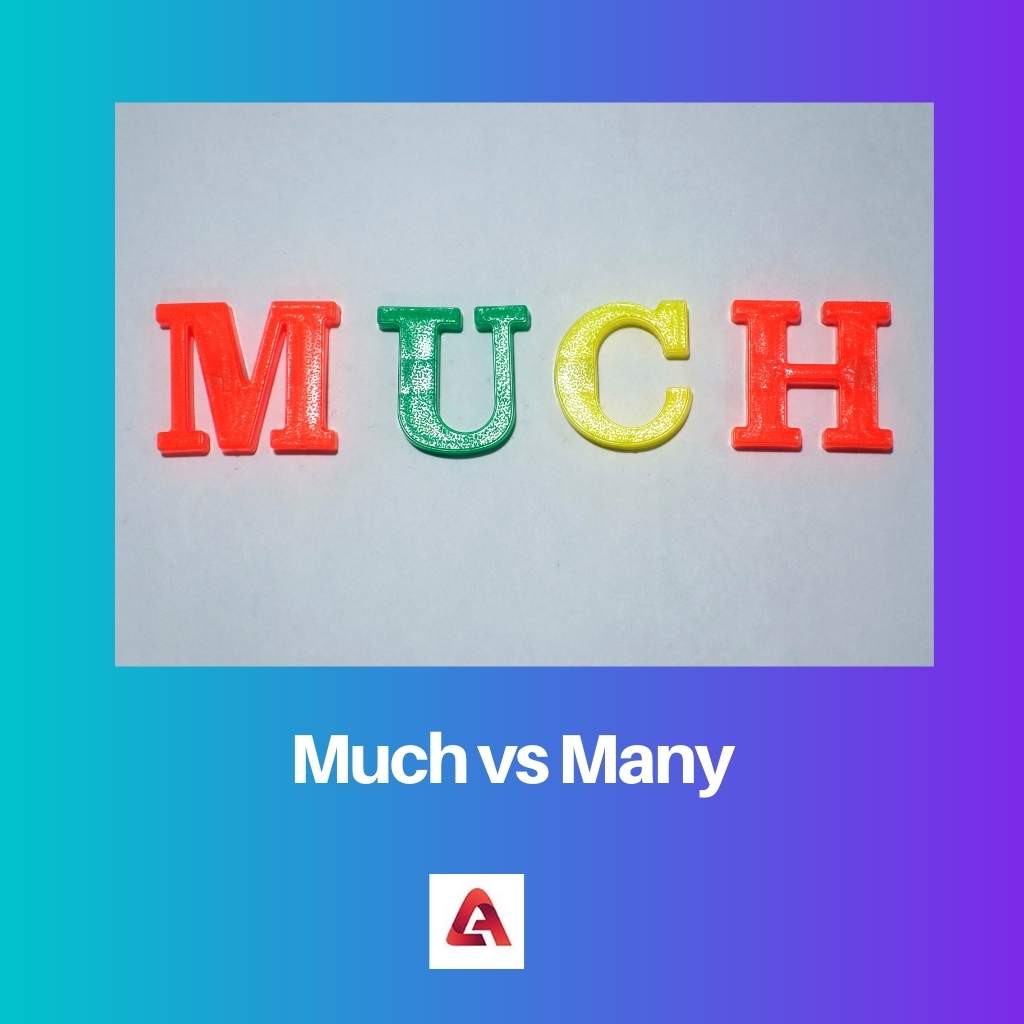There are many words in the English language where people may confuse two words thinking both have the same meaning and can be used in the same context, but that is not the case.
Key Takeaways
- Much is used to describe uncountable nouns, while many describe countable nouns.
- Much is used in negative and interrogative sentences, while Many are used in positive ones.
- Much is used with singular nouns, while Many are used with plural nouns.
Much vs Many
Much is used to describe an amount of something that cannot be counted or is considered singular, such as a quantity of liquid or an abstract concept. For example, “I didn’t drink much water today”. Many is used to describe a number of things that can be counted, such as people, objects, or animals. For example, “There are many people in the park”.

The word ‘Much’ is the word that is used in a sentence to denote nouns that are not Countable. This word is used for nouns in their singular form in a sentence.
The word ‘Many’ is a word that is used in a sentence to denote countable nouns. This word is used for nouns in their plural or collective form.
Comparison Table
| Parameters of Comparison | Much | Many |
|---|---|---|
| Where it is used | The word ‘Much’ is used for uncountable nouns in a sentence. | The word ‘Many’ is used for countable nouns in a sentence. |
| Form of nouns | The word ‘Much’ is used for nouns that are in the singular form in a sentence, | The word ‘Many’ is used for nouns in a collective form in a sentence. |
| Meaning | The word ‘Much’ is used in a sentence when the amount is significant. | The word ‘Many’ is used when the amount of something is large in number. |
| Type of sentence | The word ‘Much’ is used in interrogative and negative sentences by a person. | A person uses the word ‘Many’ in affirmative, interrogative, and negotiating sentences. |
| Synonym | The word ‘Much’ synonyms are many, plenty, etc. | The synonyms of the word ‘Many’ are various, numerous, countless, etc. |
What is Much?
The word ‘Much’ is the word that is used in a sentence to denote nouns that are not Countable. This word is used for nouns in their singular form in a sentence.
In a sentence, this word is also used in front of words that help the comparison of two things in a sentence. These words include words such as too, as, etc. When this word is used in a sentence, it denotes that something does not happen that often.
Following are specific examples where the word ‘Much’ is used in a sentence-
- How much quantity of rice do you want?
- This is so much drama!
- We had so much fun that day.
- I wouldn’t say I like strawberries as much as I like blueberries.
- I don’t have that much money right now.

What is Many?
The word ‘Many’ is a word that is used in a sentence to denote countable nouns. This word is used for nouns in their plural or collective form. When this word is used in a sentence, it helps to state many people or something.
It is observed that the word ‘many’ is followed by an article and a noun in a sentence. This happens when a person wants to denote a sense of empathy; many things or people are involved in a particular situation.
Following are the examples where the word ‘Many’ is used in a sentence-
- I have so many stamps collected at home.
- We have so many members on our mothers’ side of the family.
- There are too many apples as compared to mangoes.
- I have many dolls.
- Many people visit the church on Christmas evening.

Main Differences Between Much and Many
- The word ‘Much’ is used in interrogative and negative sentences by a person. On the other hand, the term ‘Many’ is used in affirmative, interrogative, and negotiating sentences by a person.
- The synonyms of the word ‘Much’ are a lot, plenty of, etc.; on the other hand, ‘Many’ are various, numerous, countless, etc.

- https://ieeexplore.ieee.org/abstract/document/6588857/
- https://www.sciencedirect.com/science/article/pii/S0010028584710048

An excellent exposition on the distinctions between ‘much’ and ‘many’. The author’s attention to detail and lucid writing style make this a standout contribution to grammar literature.
This article does justice to the discussion of ‘much’ and ‘many’, providing a commendable reference for those seeking to master the intricacies of the English language.
Absolutely, Greg Campbell. The rigorous approach in elucidating subtle language nuances is both educational and engaging for readers invested in language studies.
The content of this article is indeed valuable for English language learners. The meticulous comparisons and examples make it a truly enlightening read.
I concur with your assessment, Tracy Stewart. The thoroughness exhibited in the article’s content renders it a commendable source for language enthusiasts.
Well put, Tracy Stewart. The meticulous approach adopted in explaining these grammar intricacies is what sets this article apart as a beneficial learning tool.
This article serves as a great reminder for individuals who may occasionally confuse the usage of ‘much’ and ‘many’. The examples provided offer a practical understanding of these differences.
A commendable aspect of this article is the way it illustrates the rules through real-life examples. It definitely aids in solidifying these grammar concepts in one’s mind.
I found the comparison table to be particularly helpful in highlighting the distinctions between ‘much’ and ‘many’. The visual representation makes it easier to comprehend.
The article is insightful, and the distinction between ‘much’ and ‘many’ is delineated with utmost clarity. Kudos to the writer for presenting such a comprehensive guide.
I share your sentiment, Griffiths Kevin. The author has succeeded in simplifying a complex grammar topic by offering a methodical and logical breakdown.
The detailed exploration of ‘much’ and ‘many’ endows readers with a heightened understanding of these grammatical elements. A commendable effort by the writer.
While this is a well-written article, I believe that the discussion of ‘much’ and ‘many’ could be made even more extensive. There are other nuances that could be explored.
I agree with your suggestion. Adding further details about the usage of ‘much’ and ‘many’ in different scenarios would enhance the comprehensiveness of this article.
You raise an interesting point, Tjohnson. It would be beneficial to further elaborate on the specific contexts in which these words are used.
This article is very informative and will help many individuals improve their English language skills. You’ve done an excellent job covering the topic.
I completely agree with you. The author has done a great service to all English learners by explaining this topic in such a clear and thorough manner.
It’s always beneficial to have a solid grasp of grammar rules, and this article provides just that. A valuable resource for those who want to enhance their language proficiency.
The article offers a thorough dissection of ‘much’ and ‘many’, bolstered by a compelling presentation. It’s a valuable addition to the body of work aiding language learners.
Agreed, Wood Jamie. This article stands out as an indispensable resource for learners seeking clarity on ‘much’ and ‘many’.
I share your views, Wood Jamie. The comprehensive and systematic breakdown of these grammar components is a testament to the author’s expertise.
The meticulous approach in expounding the differences between ‘much’ and ‘many’ is commendable. This article is an asset to English language educators and learners alike.
Spot on, Ncampbell. The insights offered in this article aptly cater to the needs of both educators and language enthusiasts by delivering clarity on a complex subject.
This article stands as a testament to the author’s mastery of the English language, providing an authoritative guide for grasping the distinctions between ‘much’ and ‘many’.
The author has effectively clarified the confusion surrounding ‘much’ and ‘many’. This article is bound to be a valuable resource for English language learners around the world.
Absolutely. The lucid explanations and multiple examples make it conducive for language learners at various proficiency levels to grasp the concepts.
I couldn’t agree more, Elizabeth20. The structured explanation provided in this article can certainly aid English learners in mastering these grammar nuances.
Thank you for such a helpful article! The explanation of the differences between ‘much’ and ‘many’ was clear and easy to understand.
Indeed, there are many instances where these two words are confused. It’s always great to find an article that explains their differences in such detail.